If you haven’t done so yet, then most likely you have been late for work, appointments, and have generally been behind everyone around you. It has been nearly two weeks since Daylight Savings Time went into effect. That night everyone lost one hour of their beauty rest, only to gain that hour in offering more ‘daylight’ time in the evenings for the upcoming summer months.
Daylight Savings Time was first proposed in 1895 by a individual from New Zealand, by the the name of George Vernon Hudson. Though Hudson fathered in the modern era of Daylight Savings Time, one of the first to incorporate a daylight schedule was the Roman Empire. Their water clocks had different weights for different months of the year offering more light in the summer months and less during the winter.
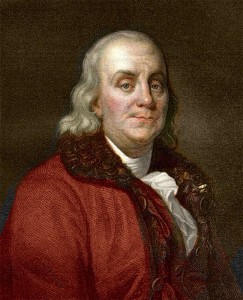
Benjamin Franklin, who penned the proverb, “Early to bed, and early to rise, makes a man healthy, wealthy and wise,” suggested people use their time wisely by rising earlier in the morning to use the sunlight rather than waste candles. The idea was taken further by proposing taxes on shutters, rationing of candles, and using church bells or cannons at daylight to wake sleeping citizens.
From colonial days until after the Civil War, there wasn’t any official time stamp. As rail lines spanned the vast country, hectic time schedules followed. On October 11, 1883, officials from the major railroad met in Chicago and adopted the Standard Time System, which had been introduced by a Canadian named, Sanford Fleming in 1879. Soon states adopted the system and the Standard Time Act on 1919 was established as U. S. law including Daylight Savings time. One year later the law was repealed, but during World War II, it was re-instated. Today, only Arizona and Hawaii, are the only two states in the United States that do not observe Daylight Savings time.
This article came about after discovering, amongst my many clippings of newspaper articles, a report from The Kittanning Times, Thursday, February 24, 1921. The title of the article, DAYLIGHT SAVINGS PLAN GIVEN BIG SETBACK. The article begins by stating that Kittanning is planning on sticking to the present Eastern Standard time. At a meeting that was conducted in the council chambers, Daylight Savings plan was kicked into the discard by a vote of 35 to 105.
Petitions against the change were presented during the meeting from about 600 men which operated under three different local miners’ unions. Members from the unions as well as members of the clay workers union were present to voice their dislike of the plan. Councilman John Barger presided over what must have been a heated discussion concerning the changing of the clocks. Neal Heilman spoke in favor of the plan, and O. N. Wilson declared that this, “was not a daylight savings plan but a long evening plan”. He was in favor of giving the workingmen and farmers who support Kittanning, the benefit of the doubt and advocated the defeat of the measure. E. O. Golden, attorney in Kittanning signed the petition, thinking that workingmen would benefit from it.
Individuals from the Plate Glass Company, John Crossett representing his employees and a Mr. McMaddis that represented some clay workers all stated their employees wanted no part in daylight savings. Rev. R. P. Anderson, who favored the idea as during the war, but since it was interfering with church attendance, he was against it. J. C. Easley, who offered a voice from farmers also declared them against the measure.
When the vote was called for, Councilman Borger stated that only residents of Kittanning would be permitted to vote. The article does not state what occurred but it does sound like tensions were tight when and appeal was overturned. Finally, the decision was made that those in favor of enacting daylight savings move to one side of the chamber and those opposed move to the other side. In the end, 105 present voted against the measure and only 35 voted in favor.
I am not sure when this measure would have been changed repealed in Kittanning, but from the Leader times, September 25, 1937, clock-turner, Ted Lindeman, will put Kittanning back on Eastern Standard time at 9pm. To make this ‘official’ switch, Lindeman must climb the stairs of the tower on the James McCullough building, which is located on the 200 block of Market Street., and set the towns clock to the correct time.
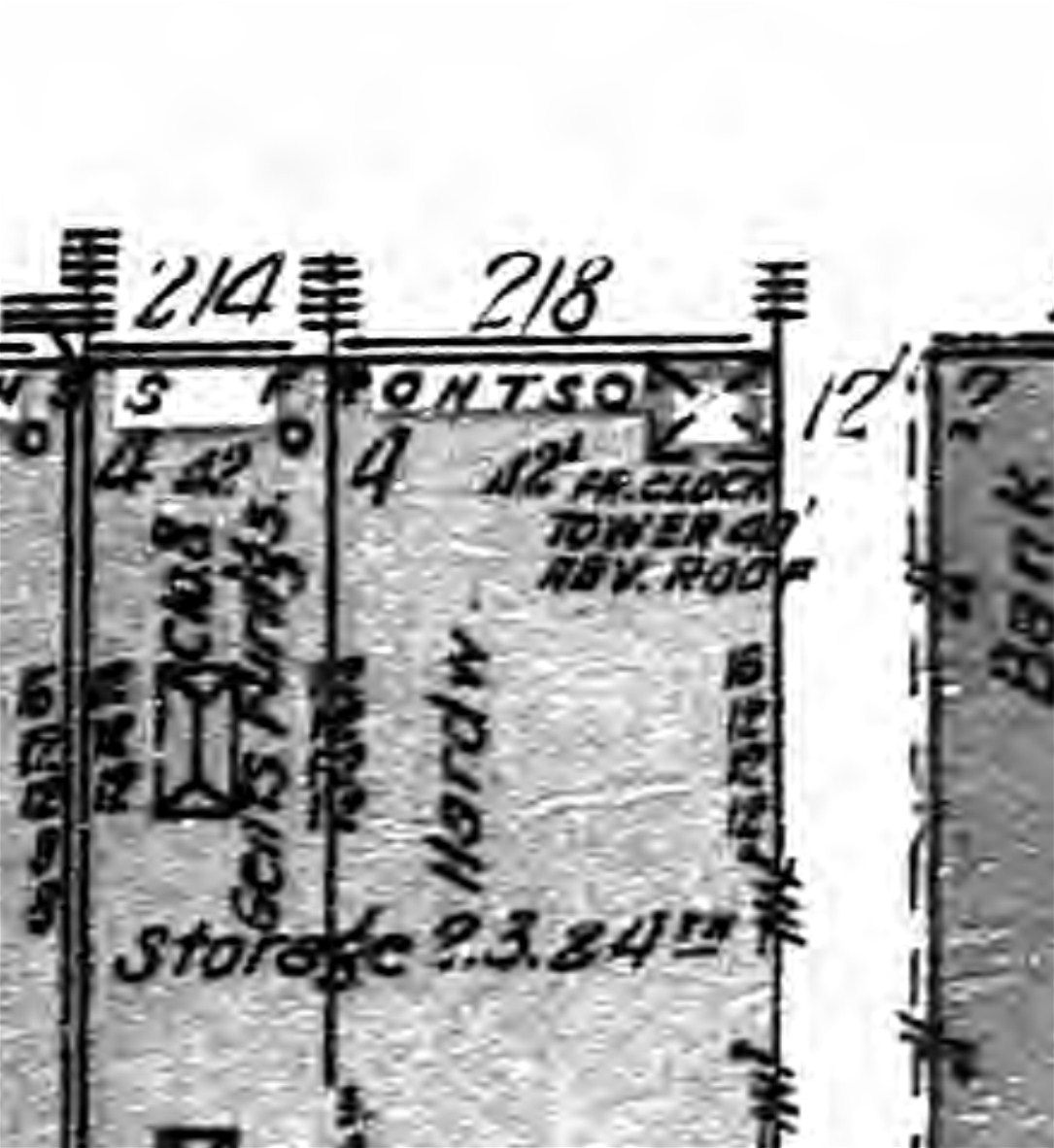
Since we are discussing time, I thought I would take the ‘time’, and share some history that I have been actively pursuing, concerning the lofty tower that once gave time for all that gazed into the air. I was told a story as to the reason for building such a tower, but have really never been able to document it as fact. I recently shared with the readers of kittanningonline.com a large fire that destroyed the 200 block of Market Street in 1897. The result of this fire was the building of two large and towering structures that still grace the street today.
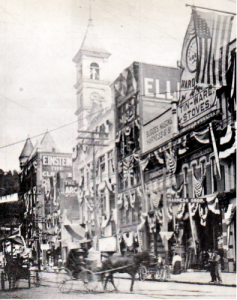
The 5 story Ellermeryer Building was constructed first in the 1898 and was followed by the 4 story James McCullough building. McCullough built a small peaked tower on the corner of building in the beginning.
The story goes,..that in 1905 Kittanning Borough decided to built a large bell tower on city hall across the street from McCullough’s building. Not wanting to be left out, McCullough removed his small tower and placed a large tower housing a bell and a clock to offer the time to residents of the town. This project was completed the following year. The bell, which was dated 1906, was cast by the McShane Bell Foundry in Baltimore, Maryland.
Today, many never knew that a large tower housing a four faced clock, and a McShane Bell once rang out the hours in downtown Kittanning. 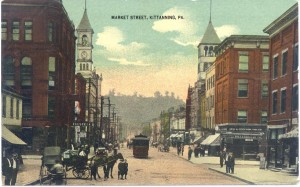 Many turn of the century photos offer a wonderful glimpse of this long forgotten treasure. In 2001 I started to work on research about the bell tower, and began to question several elder citizen’s about the tower and what became of it. Very little insight was found. I made several telephone calls to former managers, clerks and custodians of the G. C. Murphy Company, which operated from the building from 1938 until closing in 1992. Again, many remembered the tower being on top of the building, but there wasn’t anyone that remembered the dismantling of the tower.
Many turn of the century photos offer a wonderful glimpse of this long forgotten treasure. In 2001 I started to work on research about the bell tower, and began to question several elder citizen’s about the tower and what became of it. Very little insight was found. I made several telephone calls to former managers, clerks and custodians of the G. C. Murphy Company, which operated from the building from 1938 until closing in 1992. Again, many remembered the tower being on top of the building, but there wasn’t anyone that remembered the dismantling of the tower.
I had the fortune to locate the mammoth bell and photograph
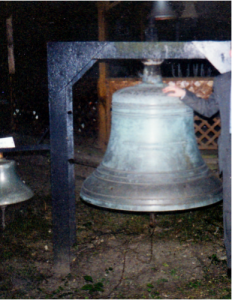
and video tape its hammer once again bring to life the 100 year plus bell as it sharp robust tone rang out over the property. At that time, the bell was housed at a place called Bell Haven, West of Natrona Heights. I recently spoke to a descendant and was informed the bell was sold 4 years ago to a individual from Columbus, Ohio. I haven’t been successful in making contact with this person.
I haven’t been able to locate the manufacture of the four faced clock. It wasn’t until this past month that I discovered an brief mention in the Leader Times that the tower on the McCullough building was obtained from a building in Washington, PA and that in 1960, the tower was being stored in the McCullough warehouse. I also recently have discovered as to when the tower, bell and clock were removed from the building. From Pages from the Past, in the Leader Times, Monday, July 29, 1968. Twenty years ago, Friday, July 29, 1948 ~ Pigeons will lose a snug roost and the old town clock will no longer tick away above Kittanning streets after workmen finish dismantling the clock and tower in the old McCullough building.
With one small page of our past discovered, it is important to never give up one search for that elusive piece of history. Somewhere, someday, when it least unexpected, the answer just might be staring you right in the face.
It is my intent to offer some history and insight into the McShane Bell Foundry, as well as information concerning the two known McShane bells which were housed across Market Street from one another.
Credits:
The Kittanning Times, Thursday, February 24, 1921
Leader Times, Tuesday, September 27, 1960
Leader Times, Monday, September 25, 1967
Leader Times, Monday, July, 29, 1968
Askvile by Amazon.com @ http://askville.amazon.com/states-observe-daylight-savings-time/AnswerViewer.do?requestId=16674373
The McShane Bell Foundry @ http://www.mcshanebell.com/
The American Bell Association @ http://www.americanbell.org/
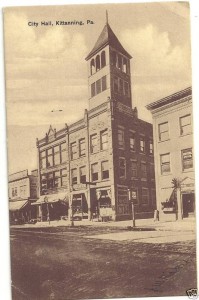
Wikipedia on Benjamine Franklin @ http://en.wikipedia.org/wiki/Benjamin_Franklin
Wikimedia.com @ http://upload.wikimedia.org/wikipedia/commons/1/10/Benjamin_Franklin_Coloured_Drawing.png
1908 Sanborn Map & Publishing Company, 117 & 119 Broadway, New York, NY
other photographs from the collection of Christopher Anthony


